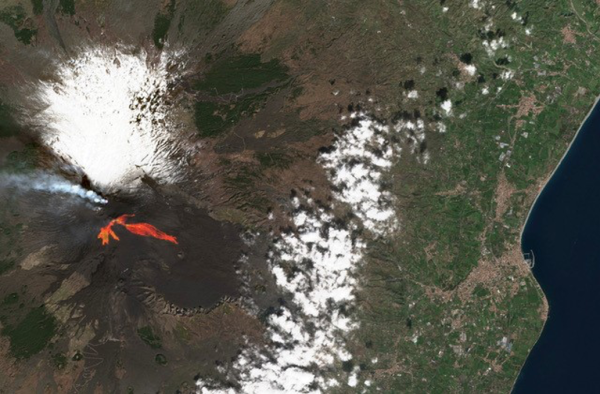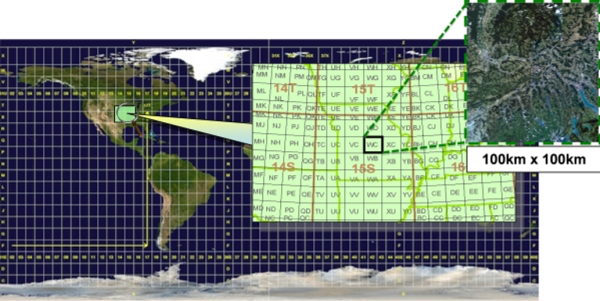The Sentinel-2 Level-1C Collection 1 represents the product dataset generated starting from processing baseline 05.XX included.
The evolutions of the processing baseline (PB) are tracked and justified in the 'Processing Baseline Status' section of the Data Quality Report that is published on a monthly basis by the Mission Performance Center (MPC) and available from the Sentinel-2 Document Library.

A Sentinel-2 Level-1C Collection 1 product provides orthorectified Top-Of-Atmosphere (TOA) reflectance, with sub-pixel multispectral and multitemporal registration accuracy. Technical quality masks are included in the product. L1C products main characteristics are listed in Table -1
| Name | Level-1C |
| High-level Description | Top-of-atmosphere reflectances in cartographic geometry for 13 spectral bands |
| Data Characteristics |
|
| DEM used | Copernicus DEM at 30 m |
| Auxiliary Data |
|
| Production & Distribution | Systematic generation and on-line distribution |
| Data Volume | Data Volume 700 MB (each 100x100 km2) |
| Data Delivery | Available within 6 hours from sensing |
L1C Products are a compilation of elementary granules of fixed size, within a single orbit. A granule is the minimum indivisible partition of a product (containing all possible spectral bands). For Level-1C and Level-2A, the granules, also called tiles, are 100x100km2 ortho-images in UTM/WGS84 projection. The UTM (Universal Transverse Mercator) system divides the Earth’s surface into 60 zones. Each UTM zone has a vertical width of 6° of longitude and horizontal width of 8° of latitude. (see Figure 2). Tiles are approximately 700 MB in size. Tiles can be fully or partially covered by image data. Partially covered tiles correspond to those at the edge or top and bottom of the Datastrip.

Resolution
The resolutions of the Copernicus Sentinel-2 mission and its payload, the MSI instrument, are threefold:
- The temporal resolution of a satellite in orbit is the revisit frequency of the satellite to a particular location. The revisit frequency of each single Sentinel-2 satellite is 10 days and the combined constellation revisit is 5 days
- The spatial resolution of an instrument is the at-ground representation of an individual detector in a satellite sensor array. Details on the spatial resolution of the MSI instrument resolution are provided in the Spatial Resolution section
- The radiometric resolution of an instrument is a determination of the incremental level of intensity or reflectance that can be represented or distinguished by the system. The higher the radiometric resolution, the more capable the device will be of detecting differences in intensity or reflectance. Details on the radiometric resolution of the MSI instrument are provided in the Radiometric Resolutions section.
Coverage Acquisition Maps
The Sentinel-2 mission provides systematic global coverage over land masses and coastal areas. Read more about Sentinel-2's Revisit and Coverage.
Quality Reports
The Coordinating Centre of the Mission Performance Centre (MPC) provides a monthly status of the Sentinel-2 product quality via the dissemination of a Data Quality Report (DQR). The report provides information on the monitoring and measurement of product performances against the proposed specification. It also documents observed anomalies and known issues, the list of defective pixels, and any processing chain improvements that lead to an increment of the Processing Baseline.
View available Sentinel-2 Data Product Quality Reports.
How to access this data
Products are freely available via the Copernicus Open Access Hub. In addition to the download services, the Sentinel Data Products are available in the Copernicus Data and Information Access Service (DIAS) cloud environments. Each DIAS provides processing resources, tools and complimentary data sources at commercial conditions to further facilitate the access to Sentinel data. Learn more about how to access Sentinel data.
Resources
- Sentinel-2 Level-1C Product Formatting
- Sentinel-2 Level-1C Processing
- Sentinel-2 Product Specifications Document
- Sentinel-2-Naming Convention
- Sentinel-2 MSI Technical Guide
- The MSI Instrument - Entry in the CEOS Missions, Instruments, and Measurements (MIM) Database
Tools
The Sentinel-2 Toolbox consists of a rich set of visualisation, analysis and processing tools for the exploitation of MSI data from the Sentinel-2 mission.
Data Citation Guidelines Collection 1
Users, who, in their research, use ESA Earth Observation data that have been assigned a DOI, are asked to use it when citing the data source in their publications:
Copernicus Sentinel-2 (processed by ESA), 2021, MSI Level-1C TOA Reflectance Product. Collection 1. European Space Agency, https://doi.org/10.5270/S2_-742ikth